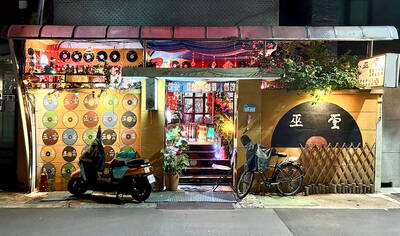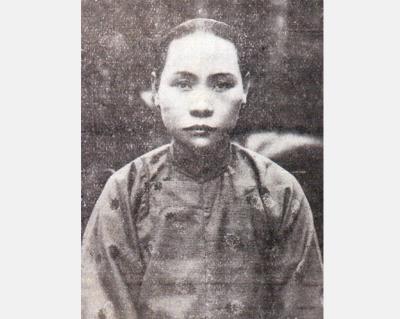At the end of a week in which George W. Bush visited Tokyo, and Japan was the country of honor at the Taipei International Book Exhibition, consideration of a book with the sub-title The Fall of Modern Japan seems apt, though not likely to make comfortable reading in all quarters.
The title itself refers to a statement by a painter in the ancient Chinese court. When the emperor asked him what was difficult to paint and what was easy, he replied "Dogs are difficult, demons are easy." What Alex Kerr means by adopting this distinction is that modern Japan has fallen victim of the desire to come up with lavish, impressive, but essentially easy to construct projects ("demons") but has ignored the more difficult, everyday things ("dogs") which make people happy, and a country prosperous in the long term.
Among these desirables he includes public accountability, the protection of historic neighborhoods, decent sized homes, buried cables and phone lines, education that is something more than cramming, and a culture that tolerates protest and encourages individual thought.
While foreigners enthuse about Zen, flower arrangement, Noh drama, haiku, tea ceremonies, and the Japanese eye for industrial design, the country hurtles down the road of thoughtless "modernization," then stops in puzzled wonder when pollutants accumulate and the economy plunges into recession. They are modern, they are hi-tech, they are progressive. Where have they gone wrong?
Kerr's is an outspoken, agonized, but ultimately deeply concerned analysis. His perspective is first and foremost ecological, and his biggest bugbear concrete, with its main victim the natural environment. This is not to say this is a simpleminded, one-issue book. The author views the ramifications of this misplaced focus as extensive, involving economic decisions and financial deals that go to the top of society. Some of the examples he quotes are frightening indeed.
The country's worst problem, Kerr believes, is government-subsidized construction. That there is a reason for this -- private gain for well-placed individuals -- doesn't need saying. This is why concrete has become a national obsession. While the Japanese continue to believe they revere nature and hold the land itself to be sacred, rivers throughout the country have been forced into ugly concrete beds, and there are even plans to lay concrete on the moon. "It won't be easy, but it is possible," said the general manager of one of Japan's largest companies' space systems division in 1996. "It won't be cheap to produce small amounts of concrete on the moon, but if we make large amounts of concrete, it will be very cheap."
Construction frenzy isn't the only accusation the author makes. In fact he has many more -- shabby cities, a film industry aimed at the mentality of children (though with some honorable exceptions), universities that don't educate, a culture of "cosmetic accounting" (ie institutionalized lying), mismanaged hospitals, a profound intellectual insularity, a Hello Kitty-fied cultural life, and so on.
Meanwhile the country displays a strong attraction to emigration, to moving into large, foreign homes set in an unspoiled environment, as far away from Japan as possible. The hostility to foreigners within Japan itself, however, remains palpable.
Japan has largely failed, Kerr writes, to build a tourism industry, citing Kyoto train station (Disneyland in the middle of a priceless heritage site) as a typical reason why. In 1998 it had four million foreign visitors, while the US had 47 million, and France 70 million.
Paralleling this failure, he cites a Japanese heiress who bought eight chateaux in France during the 1990s and proceeded to strip them of all paneling, cart away statues, and cut down trees. She was later jailed by the French authorities for cultural desecration. But she was typical, says Kerr, and in reality "only following the customs of her native land."Back home, illegal dumping proceeds apace. In 1992 Japanese police identified 1,788 cases, amounting to 2.1 million tonnes. But the arrest rate for these offenses hovered around one percent. And toxic waste remains serious, with dioxin poisoning a major problem, especially in areas close to public incinerators.
By contrast, setting up a noodle shop needs innumerable forms in triplicate. The point of this red tape is "bureaucratic control -- the restriction of business to routine paths along which officials may profit."
Alex Kerr insists he is not Japan-bashing -- he's lived there for 35 years and considers it his home. He nevertheless enjoys comparing Japanese luxury hotels with Bangkok's (where the Oriental and the Sukhotai come in for generous praise). He mentions southeast Asians working in Japan who consider its lifestyle the most culturally impoverished in the region. His affluent Thai friends would never dream of going there, he says.
If Japan is guilty of these things, it need hardly be asked, then what about Taiwan? Many, perhaps most, of the charges Kerr levels at his adopted home could be leveled here, and some with added force. Isn't Taiwan, in places at least, one gigantic garbage tip? Haven't river beds been concreted over on every hand? Aren't there abandoned cars half way down mountain slopes? The Taiwanese artist Chen Lai-hsing has written about sinister interests "conniving together for greater profits," "toxic rain [falling] like tears," and "plastic bags, beverage bottles, discarded furniture, and countless heaps of styrofoam takeout food containers strewn across the sorrowful earth."
The author claims that many of his Japanese friends have said they wouldn't dare attempt such a critique themselves, while begging him not to abandon his project. The result consequently assumes the character of representing things many ordinary Japanese feel, but that only a foreigner could ever put into print.
This forceful book engages with its subject at an accessible level. It's lively, shows no evidence of corporate-style editing, and backs up its assertions with footnotes, while remaining essentially a well-documented personal view. All in all, it makes for disturbing but never oppressive reading.
Dogs and Demons
By Alex Kerr
432 Pages
Penguin

The Lee (李) family migrated to Taiwan in trickles many decades ago. Born in Myanmar, they are ethnically Chinese and their first language is Yunnanese, from China’s Yunnan Province. Today, they run a cozy little restaurant in Taipei’s student stomping ground, near National Taiwan University (NTU), serving up a daily pre-selected menu that pays homage to their blended Yunnan-Burmese heritage, where lemongrass and curry leaves sit beside century egg and pickled woodear mushrooms. Wu Yun (巫雲) is more akin to a family home that has set up tables and chairs and welcomed strangers to cozy up and share a meal

Dec. 8 to Dec. 14 Chang-Lee Te-ho (張李德和) had her father’s words etched into stone as her personal motto: “Even as a woman, you should master at least one art.” She went on to excel in seven — classical poetry, lyrical poetry, calligraphy, painting, music, chess and embroidery — and was also a respected educator, charity organizer and provincial assemblywoman. Among her many monikers was “Poetry Mother” (詩媽). While her father Lee Chao-yuan’s (李昭元) phrasing reflected the social norms of the 1890s, it was relatively progressive for the time. He personally taught Chang-Lee the Chinese classics until she entered public

Last week writer Wei Lingling (魏玲靈) unloaded a remarkably conventional pro-China column in the Wall Street Journal (“From Bush’s Rebuke to Trump’s Whisper: Navigating a Geopolitical Flashpoint,” Dec 2, 2025). Wei alleged that in a phone call, US President Donald Trump advised Japanese Prime Minister Sanae Takaichi not to provoke the People’s Republic of China (PRC) over Taiwan. Wei’s claim was categorically denied by Japanese government sources. Trump’s call to Takaichi, Wei said, was just like the moment in 2003 when former US president George Bush stood next to former Chinese premier Wen Jia-bao (溫家寶) and criticized former president Chen

President William Lai (賴清德) has proposed a NT$1.25 trillion (US$40 billion) special eight-year budget that intends to bolster Taiwan’s national defense, with a “T-Dome” plan to create “an unassailable Taiwan, safeguarded by innovation and technology” as its centerpiece. This is an interesting test for the Chinese Nationalist Party (KMT), and how they handle it will likely provide some answers as to where the party currently stands. Naturally, the Lai administration and his Democratic Progressive Party (DPP) are for it, as are the Americans. The Chinese Communist Party (CCP) is not. The interests and agendas of those three are clear, but